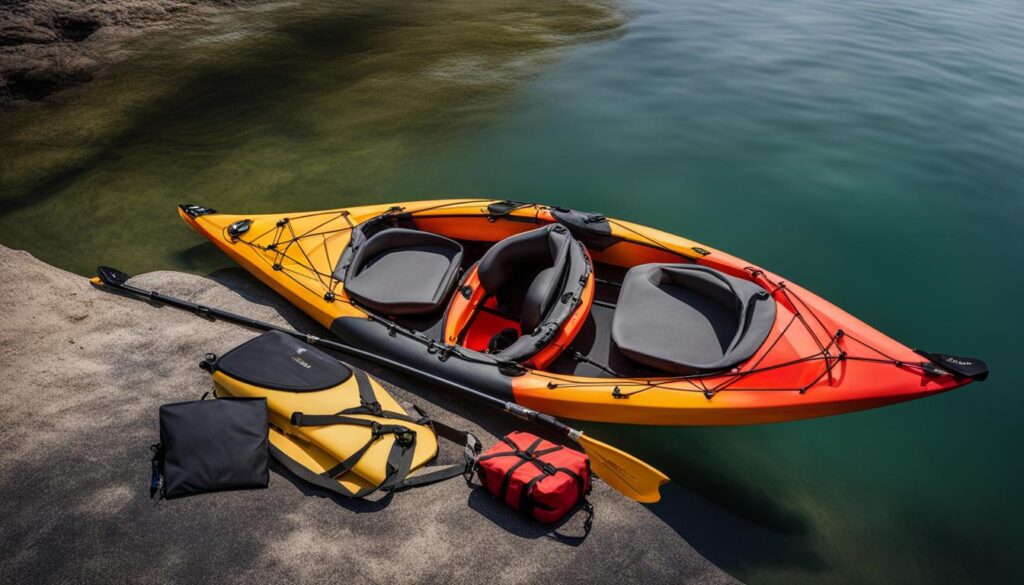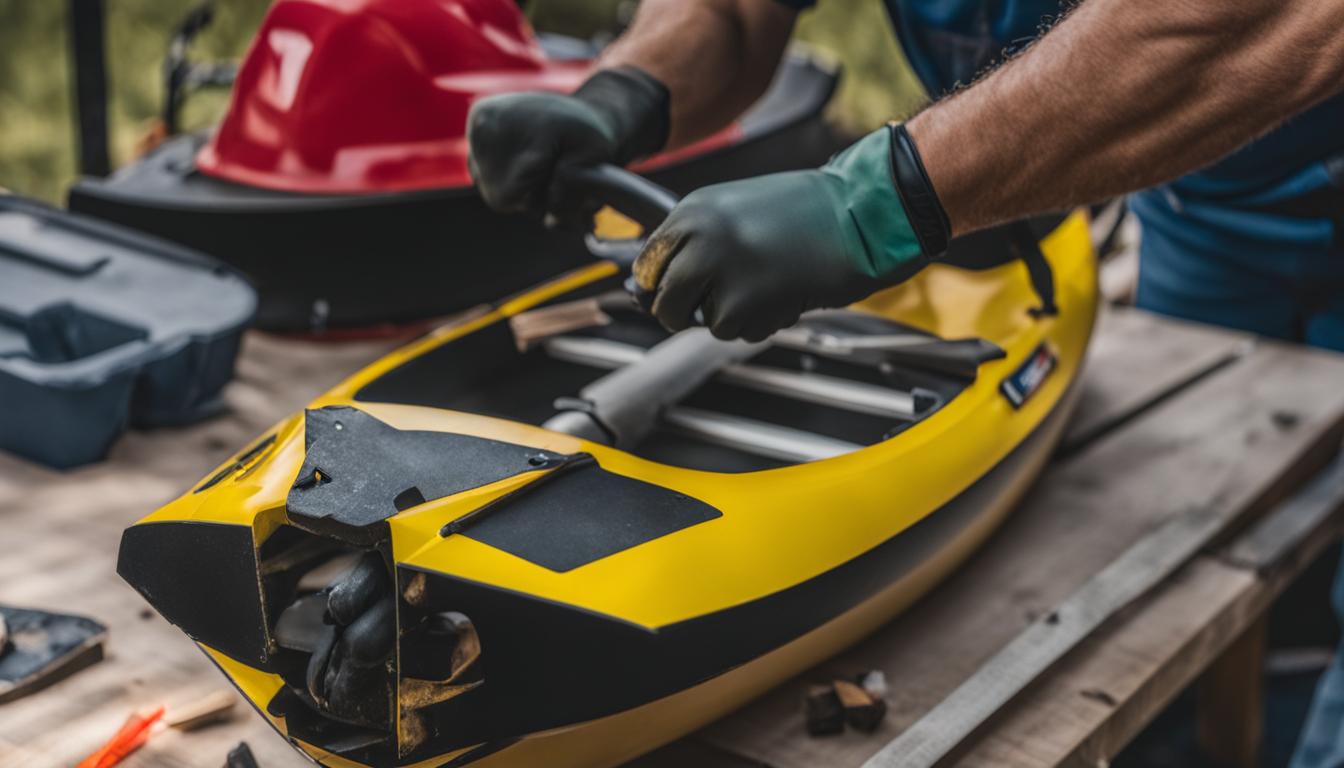Building a kayak can be a rewarding and fulfilling experience, but safety should always be the top priority. By following certain considerations during the construction process, you can ensure that your kayak is safe to use on the water. This section will explore some key safety tips and precautions to keep in mind when building your own kayak.
Key Takeaways:
- Always prioritize safety when building your own kayak.
- Follow the necessary safety tips and precautions to ensure a safe and reliable final product.
- Consider weather and environmental factors during construction.
- Use appropriate safety equipment and gear.
- Stay informed about water conditions and practice good paddling techniques.
Why is Kayak Safety Important?
Kayak safety is a crucial aspect of enjoying your time on the water. Whether you’re an experienced paddler or a beginner, it’s essential to prioritize safety to prevent accidents and ensure a smooth and enjoyable experience. When building your own kayak, following safety guidelines is equally important. By incorporating safety measures during construction, you can create a sturdy and reliable kayak that will keep you safe during your adventures.
One of the main reasons why kayak safety is important is to prevent injuries. Kayaking involves physical exertion, unpredictable waters, and potential obstacles, all of which can pose risks if proper safety precautions are not taken. By considering safety during the construction phase, you can reduce the chances of accidents caused by weak structures or inadequate equipment.
Moreover, kayak safety is crucial for maintaining control and confidence while navigating the water. A well-built kayak ensures stability and maneuverability, allowing you to handle various water conditions with ease. By following safety guidelines during construction, you can create a kayak that will support your skills, enhance your experience, and give you peace of mind.
Benefits of Kayak Safety Measures During Construction
- Minimize the risk of accidents and injuries.
- Enhance control and stability on the water.
- Improve overall paddling experience.
- Build confidence in your kayak’s performance.
- Ensure the longevity and durability of your kayak.
By implementing proper safety measures during kayak construction, you can enjoy your time on the water with peace of mind. Taking the necessary precautions will not only protect you from potential harm but also contribute to the longevity and performance of your kayak.

Table: Key Kayak Building Safety Guidelines
| Category | Safety Guidelines |
|---|---|
| Materials and Tools | Use high-quality materials and tools appropriate for kayak construction. Avoid using damaged or defective materials. |
| Workspace | Ensure a well-ventilated and well-lit workspace. Keep your work area clean and organized to prevent accidents caused by clutter. |
| Protective Gear | Wear appropriate safety gear, including gloves, safety glasses, and hearing protection, when handling tools and materials. |
| Structural Integrity | Follow the manufacturer’s instructions or reputable kayak building guides to ensure proper structural integrity throughout the construction process. |
| Finishing and Coating | Apply appropriate coatings and finishes to protect your kayak from water damage and ensure longevity. Allow sufficient drying and curing time. |
| Testing and Inspection | Thoroughly test and inspect your kayak before taking it out on the water. Check for any potential vulnerabilities or defects that may compromise safety. |
Essential Safety Tips for Kayak Construction
When building your own kayak, it is crucial to prioritize safety to ensure a secure and reliable final product. By following these essential safety tips, you can minimize the risk of accidents and build a kayak that will provide you with a safe and enjoyable experience on the water.
1. Choose the Right Workspace
Find a well-ventilated and adequately lit area to work on your kayak. Ensure that the space is free from clutter and provides enough room for you to maneuver comfortably during the construction process. Having a clean and organized workspace will help prevent accidents and make your building process more efficient.
2. Wear Protective Gear
Prioritize personal safety by wearing appropriate protective gear while building your kayak. This may include safety goggles, gloves, and a dust mask to protect your eyes, hands, and lungs from dust, debris, and fumes. Wearing the right gear will safeguard you from potential injuries and ensure a safe working environment.
3. Follow Instructions and Guidelines
When using kayak building kits or following DIY plans, carefully read and understand all instructions and guidelines before starting construction. This will help you avoid mistakes and ensure that each step is completed correctly. Following the manufacturer’s guidelines will also ensure that your kayak is built to the highest safety standards.
4. Use the Right Tools and Materials
Ensure that you have the right tools and materials for the job. Using improper tools can result in accidents or compromised construction. Invest in high-quality tools and use materials specifically recommended for kayak building to guarantee the structural integrity and safety of your kayak.
5. Work in a Well-Ventilated Area
When using adhesives, paints, or any chemicals during the construction process, make sure to work in a well-ventilated area or use a respirator to avoid inhaling harmful fumes. Additionally, ensure that you dispose of waste materials and chemicals properly, following all local regulations and guidelines.
By following these safety tips, you can create a kayak that meets the highest safety standards and confidently embark on your kayaking adventures.
| Safety Tips for Kayak Construction | Key Points |
|---|---|
| Choose the Right Workspace | Find a well-ventilated and clutter-free area to work on your kayak. |
| Wear Protective Gear | Ensure your personal safety by wearing goggles, gloves, and a dust mask. |
| Follow Instructions and Guidelines | Carefully read and understand all instructions before starting construction. |
| Use the Right Tools and Materials | Invest in high-quality tools and use recommended materials for kayak building. |
| Work in a Well-Ventilated Area | Avoid inhaling harmful fumes by working in a well-ventilated space. |
Equipment for Safe Kayaking
When embarking on a kayaking adventure, it is crucial to have the right equipment to ensure your safety on the water. Whether you are a beginner or an experienced kayaker, having the essential gear for kayak building safety can make all the difference in preventing accidents and ensuring a smooth and enjoyable trip.
One of the most important pieces of safety equipment for kayaking is a personal flotation device (PFD). This is a life-saving device that should be worn at all times while on the water. A PFD will keep you afloat in case of capsizing or unexpected falls into the water. Make sure to choose a PFD that fits properly and is approved by the appropriate safety authorities.
In addition to a PFD, wearing a helmet is also recommended, especially if you are kayaking in rough or rocky waters. A helmet will protect your head from potential injuries in case of collisions with rocks or other objects. It is important to choose a helmet that is specifically designed for kayaking and fits securely on your head.
Another essential piece of safety equipment is a dry suit or wet suit, depending on the water temperature. These suits provide insulation and protect your body from hypothermia in cold water conditions. It is important to choose a suit that is the right size and provides adequate insulation for the water temperature you will be kayaking in.
Other gear that can enhance your safety on the water includes navigation devices such as compasses or GPS systems, which can help you navigate and stay on course. Additionally, having supporting items like backrests and dry bags can improve your comfort and protect your belongings from water damage.

Table: Essential Safety Gear for Kayaking
| Equipment | Description |
|---|---|
| Personal Flotation Device (PFD) | A life-saving device that keeps you afloat in case of accidents or falls into the water. |
| Helmet | Protects your head from potential injuries in rough or rocky waters. |
| Dry Suit or Wet Suit | Insulates your body and protects you from hypothermia in cold water conditions. |
| Navigation Devices | Compasses or GPS systems that help you navigate and stay on course. |
| Backrest | Provides support and improves comfort during long paddling trips. |
| Dry Bags | Waterproof bags that protect your belongings from water damage. |
By ensuring that you have the appropriate equipment, you can enhance your safety on the water and be prepared for any unforeseen situations. Remember to always wear your PFD, choose the right gear for the water temperature, and stay informed about the weather and water conditions. With the right equipment, you can enjoy a safe and unforgettable kayaking experience.
Conclusion
In conclusion, when it comes to building a kayak, prioritizing safety is paramount. By implementing effective risk management strategies and following necessary safety precautions, you can ensure a safe and enjoyable experience on the water.
Always stay informed about weather and water conditions before embarking on any kayaking adventure. This will help you make informed decisions and avoid potential hazards. Additionally, wearing the appropriate safety gear, such as personal flotation devices (PFDs) and helmets, is crucial for your protection.
Remember to practice safe kayak construction techniques, adhering to the recommended guidelines and precautions. By doing so, you can minimize the likelihood of accidents or equipment failures.
By following these safety measures and constructing a kayak with care, you can embark on your paddling journeys with peace of mind and confidence. Put safety first, enjoy the thrill of kayaking, and create lasting memories on the water.
FAQ
Why is kayak safety important?
Kayak safety is important to protect yourself from potential injuries, avoid accidents, and navigate the water with confidence.
What safety tips should I consider during kayak construction?
Some key safety tips to consider during kayak construction include weather and environment safety, equipment safety, and personal safety.
What equipment do I need for safe kayaking?
Essential equipment for safe kayaking includes personal flotation devices (PFDs), helmets, dry suits or wet suits, navigation devices, and supporting items such as backrests and dry bags.





